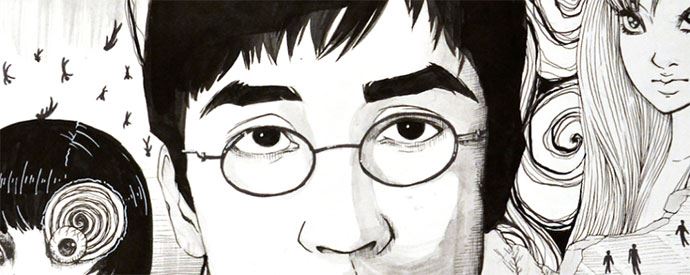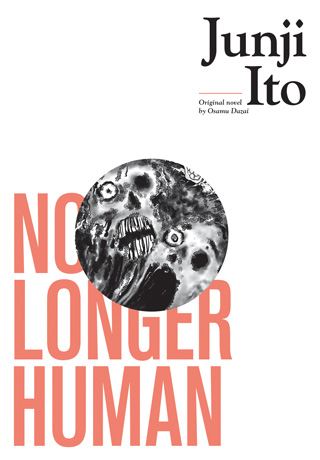Comics /
Manga
No Longer Human manga review

By Leroy Douresseaux
December 18, 2019 - 13:36
 |
| No Longer Human Graphic Novel Volume 1 cover image |
Rated “M” for “Mature”
Junji Ito is a Japanese horror mangaka (comic book writer-artist) who has created both long-form horror manga series and manga short stories. VIZ Media has published several hardcover collections of Junji Ito's manga short stories over the last five years, including Fragments of Horror (June 2015) and Smashed: Junji Ito Story Collection (April 2019).
One of Ito's recent works is a manga adaptation of Ningen Shikkaku, the 1948 Japanese novel from author, Osamu Dazai (as translated by Donald Keene). Considered one of the foremost fiction writers of 20th-century Japan, Dazai took his own life shortly after the last part of Ningen Shikkaku was published. Ningen Shikkaku is one of Japan's all-time best-selling novels and was first published in serial form.
Junji Ito's Ningen Shikkaku was collected in three tankobon (graphic novel) volumes. VIZ Media's latest Junji Ito publication is No Longer Human, a collection of Ningen Shikkaku Volumes 1-3 in one hardcover mini-omnibus (5 1/2 × 7 7/8 trim size).
No Longer Human focuses on Yozo Oba. As a boy, he realizes that he is afraid of people. He alleviates his fear by being a joker and class clown who dances, sings, tells jokes, and makes funny faces. As an adult, Yozo is plagued by a maddening anxiety because there is a terrible disconnect between his own concept of happiness and what he sees as the joy of the rest of the world.
Yozo Oba plays the clown in his dissolute life, holding up a mask for those around him as he spirals ever downward. He is a liar and becomes a womanizer. He is a drunk and eventually becomes a drug addict. Seemingly locked arm-in-arm with death, Yozo comes to believe that he must rid himself of the “10 misfortunes” that have always been packed inside of him, but can even doing that save him from the hell that is his life?
THE LOWDOWN: I have never read Osamu Dazai's Ningen Shikkaku, which apparently literally translates as “Disqualified From Being Human” and which some people consider to be an autobiographical novel. In fact, I had heard of neither author nor novel until I did some research after I received a review copy of No Longer Human from my VIZ Media rep.
I will be honest with you, dear reader, that I have never disliked any of Junji Ito's work that I have read. There have been some manga that I thought were just okay or good, but I have yet to come across Junji Ito manga that I consider a failure or a misfire. I still have not found failure as of just having finished No Longer Human, which I enjoyed immensely.
Mesmerizing and hauntingly beautiful, No Longer Human is poignant, tragic, and delicate, but is also grotesque, wrenching, and cruel. It is as if Ito uses his prodigious talents to torment us with a magnificent and gorgeous graphical storytelling presentation that is actually presenting all that is weak, pathetic, selfish, narcissistic, greedy, banal, and evil in humans.
I guess that No Longer Human could be described as psychological horror. Because Ito has listed the American author of horror and dark fantasy short stories, H.P. Lovecraft, as one of his influences, I think No Longer Human tells a story of existential horror and terror. Much of Lovecraft's work deals with existential terror and threats both existential in nature and supernatural in origin. No Longer Human offers images that are connected to existential horror and terror, and while there are supernatural elements in the narrative, the story is itself not supernatural.
Jocelyn Allen's translation and English adaptation of Ito's text are quite a feat. This is not the first time that Allen has adapted Junji Ito to English, capturing the unnerving calmness and relentless march of horror that defines Ito's work. James Dashiell's lettering is steady and tranquil, as if he is creating a matter-of-fact declaration of a man living a damned life.
I want to make note of the fact that Ito opens No Longer Human with what can be interpreted as a depiction of the double-suicide of Osamu Dazai and a female acquaintance. Printed in color, the passage has a dreamlike, pastoral quality that haunts this manga until its final chapter. That chapter is a total freak show of its own.
I READS YOU RECOMMENDS: Fans of Junji Ito will want the VIZ Signature edition of No Longer Human.
A+
10 out of 10
Rating: 10 /10
Last Updated: January 17, 2025 - 08:20

